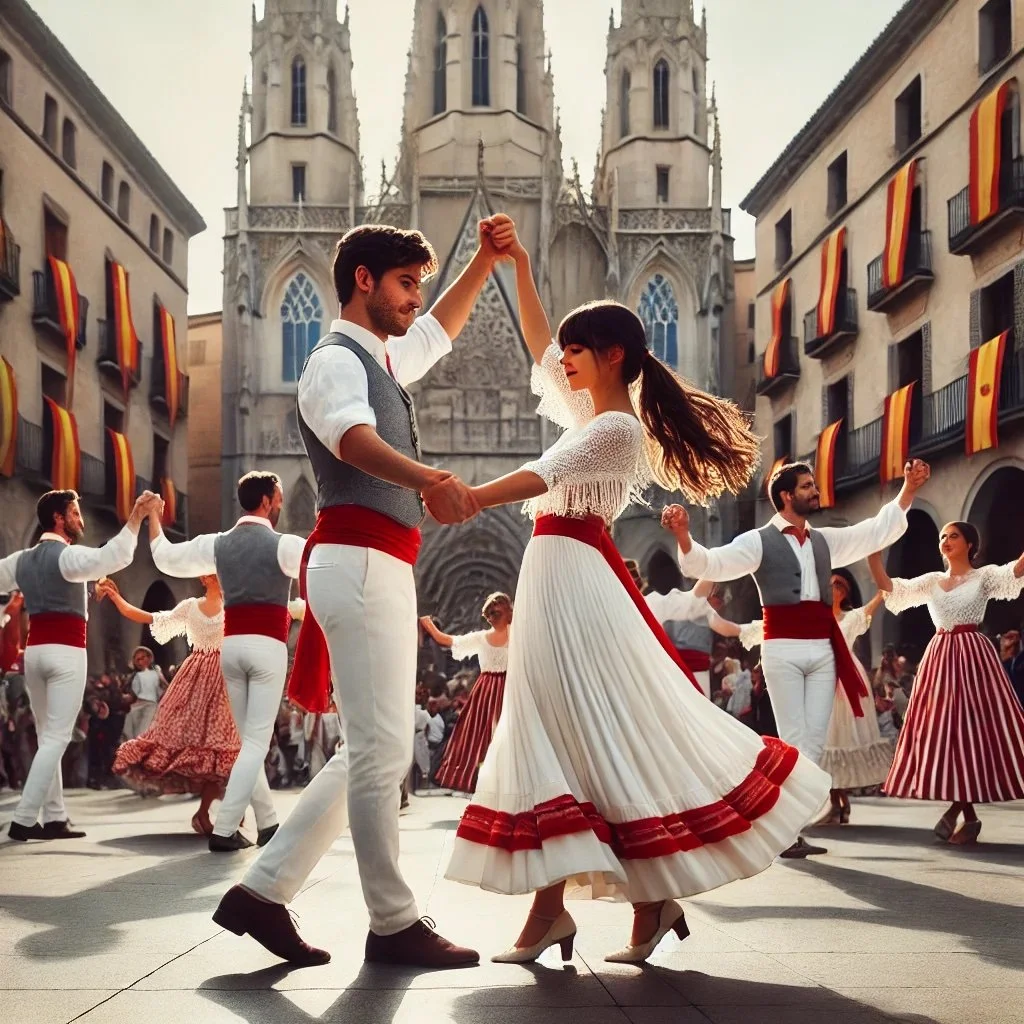Traditional Spanish Dances Beyond Flamenco: Sevillanas, Sardanas, and More
Explore traditional Spanish dances beyond flamenco, including Sevillanas, Sardanas, Jota, Muñeira, Fandango, and Bolero. Discover their origins, performances, and cultural significance.
Introduction: A Symphony of Movement and Culture
Picture yourself standing in a sunlit plaza in Seville, the air filled with the sounds of guitars and rhythmic clapping. Couples move gracefully in unison, their vibrant dresses swirling as they dance Sevillanas, a traditional Andalusian dance that captivates audiences with its elegance and passion. While flamenco often takes the spotlight as Spain’s most famous dance, the country boasts a rich tapestry of regional dances, each reflecting the unique culture and history of its people.
From the communal circle dances of Catalonia to the spirited jotas of northern Spain, traditional Spanish dances are more than just performances—they are expressions of identity, storytelling, and celebration. In this guide, we’ll explore some of Spain’s most beloved dances beyond flamenco, uncovering their origins, cultural significance, and where you can witness them today.
1. Sevillanas: The Heartbeat of Andalusia
Origins and History
Sevillanas, one of Spain’s most popular folk dances, originated in Seville and the surrounding regions of Andalusia. Dating back to the 15th century, the dance evolved from Castilian folk dances and gained prominence during local fairs and festivals. Today, Sevillanas is a highlight of the annual Feria de Abril (April Fair) in Seville, where locals and visitors alike gather to dance and celebrate.
Characteristics and Performance
Music: Typically performed to lively guitar music accompanied by clapping and singing.
Structure: The dance is divided into four distinct sections, each with its own choreography.
Costumes: Women wear colorful, ruffled dresses known as trajes de flamenca, while men don traditional short jackets and wide-brimmed hats.
Where to Experience Sevillanas
Feria de Abril in Seville
Local festivals and fairs across Andalusia
Cultural performances in tablaos and theaters
2. Sardanas: The Symbol of Catalan Unity
Origins and History
The Sardana is a traditional dance from Catalonia, symbolizing unity and cultural pride. Its origins date back to ancient Greek and Roman dances, but the modern version took shape in the 19th century, becoming a powerful symbol of Catalan identity during periods of political repression.
Characteristics and Performance
Formation: Dancers join hands in a circle, stepping in unison to the rhythm of the music.
Music: Played by a cobla, a traditional Catalan band featuring wind instruments and a double bass.
Symbolism: The circular formation represents equality and community, with no distinction between participants.
Where to Experience Sardanas
Plaça de la Catedral in Barcelona (Sunday afternoons)
Festivals like La Mercè in Barcelona and Festa Major in local towns
Cultural events across Catalonia
3. Jota: The Spirited Dance of Northern Spain
Origins and History
The Jota is a lively folk dance performed throughout northern and central Spain, with regional variations in Aragón, Navarra, Castile, and Galicia. Believed to have Moorish and medieval influences, the Jota has become a symbol of regional pride, often performed at weddings, festivals, and religious celebrations.
Characteristics and Performance
Music: Accompanied by guitars, tambourines, and castanets, with traditional folk singing.
Steps: Features quick, rhythmic footwork combined with graceful arm movements.
Costumes: Men wear short jackets, sashes, and knee-length trousers, while women don colorful skirts and shawls.
Where to Experience Jota
Fiestas del Pilar in Zaragoza
Local festivals in Aragón, Navarra, and Castile
Folklore performances in cultural centers and theaters
4. Muñeira: The Joyful Dance of Galicia
Origins and History
Muñeira, meaning “miller’s dance,” is a traditional folk dance from Galicia and Asturias, reflecting the Celtic influence in northern Spain. Historically performed to celebrate harvests and communal gatherings, the dance remains a vibrant part of local culture.
Characteristics and Performance
Music: Played on traditional bagpipes (gaita), tambourines, and drums.
Dance Style: Energetic movements with fast-paced footwork, often performed in pairs or groups.
Costumes: Women wear embroidered blouses, long skirts, and shawls, while men sport vests, knee-length breeches, and wide belts.
Where to Experience Muñeira
Festival Internacional do Mundo Celta in Ortigueira
Local festivals and pilgrimages in Galicia and Asturias
Folklore performances during cultural events
5. Fandango: The Dance of Passion and Grace
Origins and History
Originating in Andalusia, the Fandango is a passionate and improvisational dance that gained popularity in the 18th century. Known for its intricate footwork and expressive movements, the Fandango often serves as a playful competition between dancers.
Characteristics and Performance
Music: Typically accompanied by guitars, castanets, and clapping.
Dance Style: Fast-paced, with rhythmic foot stomps, spins, and dramatic pauses.
Costumes: Traditional Andalusian attire, with women wearing colorful dresses and men dressed in elegant suits.
Where to Experience Fandango
Flamenco festivals in Andalusia
Local fairs and celebrations in southern Spain
Performances at cultural centers and theaters
6. Bolero: The Elegance of Classical Spanish Dance
Origins and History
The Bolero is a classical Spanish dance that emerged in the 18th century, blending elements of ballet and folk dance. Known for its slow, graceful movements, the Bolero has influenced both Spanish and international dance traditions.
Characteristics and Performance
Music: Typically performed to classical guitar music.
Dance Style: Characterized by smooth, flowing movements combined with precise footwork.
Costumes: Elegant, formal attire reflecting the dance’s classical roots.
Where to Experience Bolero
Classical dance performances in theaters
Cultural festivals and historical reenactments
Dance schools specializing in traditional Spanish dance
Conclusion: Celebrating Spain’s Diverse Dance Heritage
Beyond the fiery passion of flamenco lies a world of traditional Spanish dances, each offering a unique glimpse into the country’s rich cultural tapestry. Whether you’re captivated by the graceful movements of Sevillanas, the communal spirit of the Sardana, or the lively rhythms of the Jota, these dances are more than performances—they are living expressions of Spain’s history, identity, and joy.
For more insights into Spanish culture and traditions, visit our blog and explore the courses offered at Polyglottist Language Academy—your gateway to a deeper understanding of Spain’s vibrant heritage.

